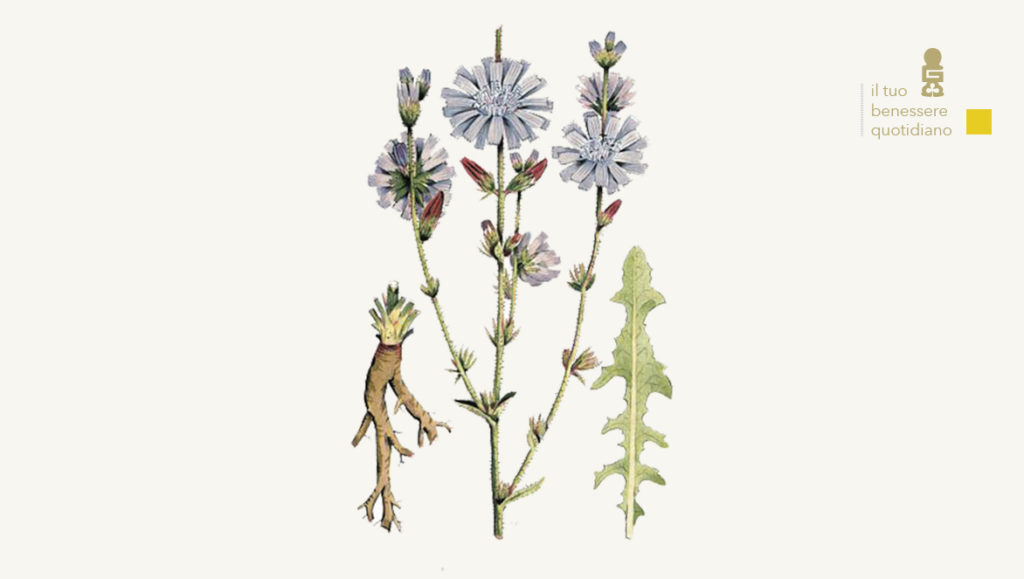Fructooligosaccharides from chicory FOS.
Chicory was cultivated since the ancient Egyptians as a medicinal plant, so much so that it is mentioned in the Ebers Papyrus. In the 1970s it was discovered that chicory root could contain up to 40% of inulin, which has negligible impact on blood sugar and thus is suitable for diabetics. From this point forward, interest in chicory has been increasing. Chicory is a medically important plant throughout Eurasia and parts of Africa, and because of its wide distribution and introduction, it is used in traditional, ethnic and folklore medicines from almost all over the world, offering phytochemicals distributed throughout the plant even though the main contents are found in the root. According to the European evaluation monograph, traditional use of chicory root includes relief of symptoms related to mild digestive disorders (such as feeling of fullness in the abdomen, flatulence and slow digestion) and temporary loss of appetite.
Several pharmacological activities have been of interest in direct studies of this plant and in particular the antibacterial, anthelmintic properties of its tannins and sesquiterpene lactones, and hepatoprotective properties. Of particular interest are the FOS, fructo-oligosaccharides, which are resistant to digestion in the stomach and small intestine because of the particular chemical configuration that makes them unassailable by human digestive enzymes; they thus behave as indigestible compounds and are cleaved into shorter chains to form butyrate, acetate, propionate, as well as hydrogen, hydrogen sulfide, methane, lactate, and succinate pyruvate, by a limited number of bacteria in the colon. Thus, a possible selection in the intestinal ecosystem in favor of bifidobacteria takes place and thus we could call them bifidogens or prebiotics.
FOS may have anticarcinogenic, antimicrobial action, hypolipidemic decreased hepatic synthesis of triglycerides and inhibition (HMG-CoA reductase) in fact HMG-CoA is the key enzyme in cholesterol synthesis exerted by propionate which is one of the products of the fragmentation of FOS and hypoglycemic since the same propionate by the previous mechanism and cascade increases glycolysis through depletion of citrate which is an allosteric inhibitor of phosphofructokinase at the hepatic level. It follows that we are also going to improve mineral absorption and balance therefore exerting anti-osteoporotic and anti-osteopenic effects. The anticarcinogenic effect could be explained by the activity of butyrate, which let us not forget is a very important energy substance for colon cells. In fact, this short-chain fatty acid, which is produced by the fragmentation of FOS in the colon, also regulates the process of cell apoptosis.
They will increase calcium and magnesium concentrations in the colon, thereby helping to control cell growth. This can be explained because high calcium concentrations in the colon can lead to the formation of insoluble salts of fatty acids, resulting in a decrease in the damaging effects of these acids on intestinal cells. In addition, the selection of the intestinal ecosystem in favor of bifidobacteria produces an inhibition of the growth of pathogenic bacteria that often cause diarrhea (Clostridium perfrigens and Escherichia coli).
BIBLIOGRAPHY
P. Bais and G. A. Ravishankar, "Cichorium intybus L.-cultivation, processing, utility, value addition and biotechnology, with an emphasis on current status and future prospects," Journal of the Science of Food and Agriculture, vol. 81, no. 5, pp. 467- 484, 2001.
- Judzentien ˇ e and J. B ˙ udien ¯ e, "Volatile constituents from aerial ˙ parts and roots of Cichorium intybus L. (chicory) grown in Lithuania," Chemija, vol. 19, pp. 25-28, 2008.
- P. Bais and G. A. Ravishankar, "Cichorium intybus L.-cultivation, processing, utility, value addition and biotechnology, with an emphasis on current status and future prospects," Journal of the Science of Food and Agriculture, vol. 81, no. 5, pp. 467- 484, 2001.
European Medicines Agency, "Community herbal monograph on Cichorium intybus L., radix," EMA/HMPC/121816/2010, 2012
- Gazzani, M. Daglia, A. Papetti, and C. Gregotti, "In vitro and ex vivo anti- and prooxidant components of Cichorium intybus," Journal of Pharmaceutical and Biomedical Analysis, vol. 23, no. 1, pp. 127-133, 2000.
- Shaikh, R. A. Rub, and S. Sasikumar, "Antimicrobial screening of Cichorium intybus seed extracts," Arabian Journal of Chemistry, 2012.
- Nandagopal and R. B. D. Kumari, "Phytochemical and antibacterial studies of chicory (Cichorium intybus L.)-a multipurpose medicinal plant, "Advances in Biological Research, vol. 1, no. 1-2, pp. 17-21, 2007
- C. Miller, S. K. Duckett, and J. G. Andrae, "The effect of forage species on performance and gastrointestinal nematode infection in lambs," Small Ruminant Research, vol. 95, no. 2-3, pp. 188-192, 2011.
- Fallah Huseini, S. M. Alavian, R. Heshmat, M. R. Heydari, and K. Abolmaali, "The efficacy of Liv-52 on liver cirrhotic patients: a randomized, double-blind, placebo-controlled first approach," Phytomedicine, vol. 12, no. 9, pp. 619-624, 2005
- Kaur and A. K. Gupta, "Applications of inulin and oligofructose in health and nutrition," Journal of Biosciences, vol. 27, no. 7, pp. 703-714, 2002.
Ohta A, Ohtsuki M, Hosoro A, et al Dietary fructo-oligosaccharides prevent osteopenia after gastrectomy. J Nutr. 1988;128:106-110
